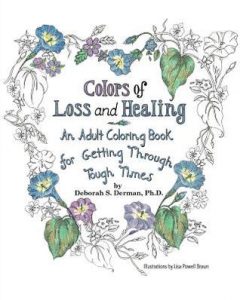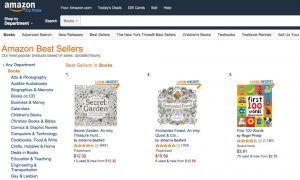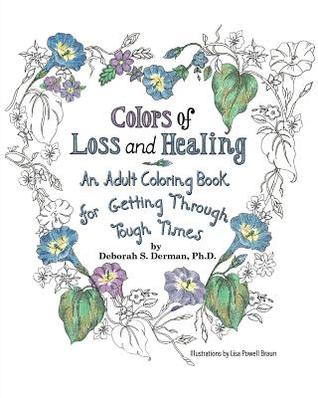
Coloring books are best sellers in bookstores, craft merchandisers, newspaper stands, and on Amazon. Now, they’re joining the health and wellness world.
The market growth of coloring books has been recognized in national media like the Washington Post, who called the phenomenon, “a bright spot in the financial results of publishers and retailers alike.” Nielsen Bookscan estimated that 12 million were sold in 2015, up from 1 million in 2014. Publishers Weekly covered the craze in November 2015.
A Forbes column said, “The adult coloring craze continues and there is no end in sight.”
Some of the mental health benefits of coloring have been noted by clinicians, such as Dr. Nikki Martinez here in Huffington Post, meditation instructor Ally Bogard on WellandGood, and art therapist Lucy Mucklow in USA Today.
Deborah Derman, Ph.D. has created a coloring book to help guide people through their journeys of loss in Colors of Loss & Healing: An Adult Coloring Book for Getting Through Tough Times. Derman is a grief and bereavement counselor who’s been in private practice for two decades. She, herself, has experienced loss of loved ones in her life: a friend through suicide, her parents in plane crash, and the sudden death of her husband. In the advent of 9/11, Derman counseled families left in the wake of the tragedy.
The coloring book incorporates what Derman has learned through both her personal grief along with observations gleaned from counseling people through their own loss experiences. Colors of Loss and Healing combines journaling, coping advice, symbolic images, and self-reflection through a structured coloring and meditative process.
“Coloring, for me, is a beautiful metaphor for taking things one small step at a time….Healing from loss is a lifelong process. We need to make meaning of the loss as we move forward in our lives,” Derman believes.
Jane Brody, long-time New York Times health columnist, wrote a lovely piece on Derman called “Coloring Your Way Through Grief” in May 2016.
 Health Populi’s Hot Points: As anxiety and depression permeate the public health burden in the U.S. and beyond, people seek solutions and hacks to live well. Based on the market demand for coloring books, it’s clear adults are picking up Crayolas, Sharpie’s, and colored pencils as an antidote to stress and sadness.
Health Populi’s Hot Points: As anxiety and depression permeate the public health burden in the U.S. and beyond, people seek solutions and hacks to live well. Based on the market demand for coloring books, it’s clear adults are picking up Crayolas, Sharpie’s, and colored pencils as an antidote to stress and sadness.
Coloring is part of artistic expression; as more people engage with arts, the healthier they can be, based on advice from The National Center for Creative Aging. The Center hosted a conference in 2014 focused on the role of artistic expression in the lives of older adults to improve health and wellbeing. Studies have shown that for people over 65, those involved in weekly art programs had fewer doctor visits and took less medication than people without creative opportunities.
Dr. Marc Agronin, Medical Director for Mental Health and Clinical Research at the Miami Jewish Health Systems (MJHS), Florida’s largest long-term care organization, noted, “a growing body of evidence indicating that creative programs for older adults improve the health and wellness of older adults.”
Consider this a form of full-on consumer-directed health.





 Thank you, Trey Rawles of @Optum, for including me on
Thank you, Trey Rawles of @Optum, for including me on  I was invited to be a Judge for the upcoming
I was invited to be a Judge for the upcoming  For the past 15 years,
For the past 15 years,